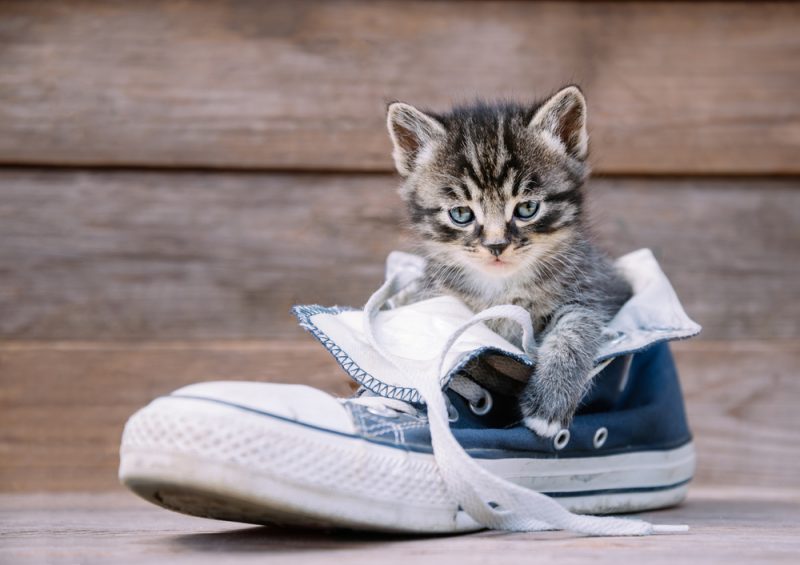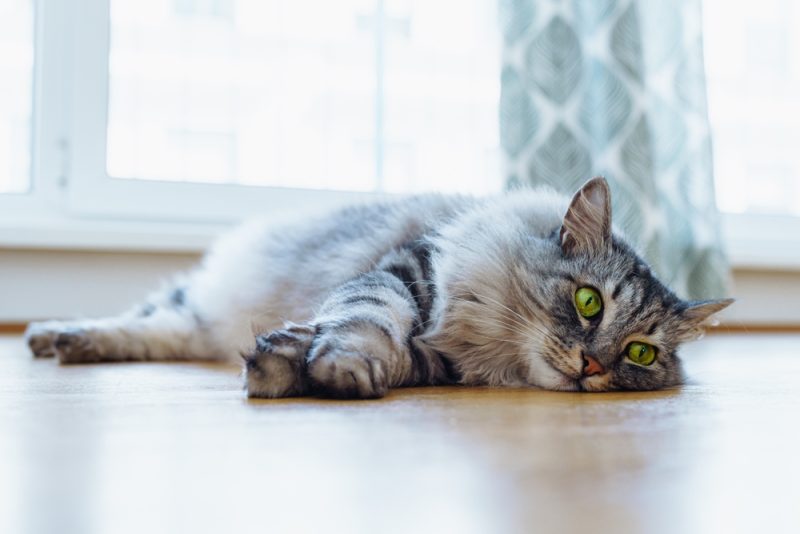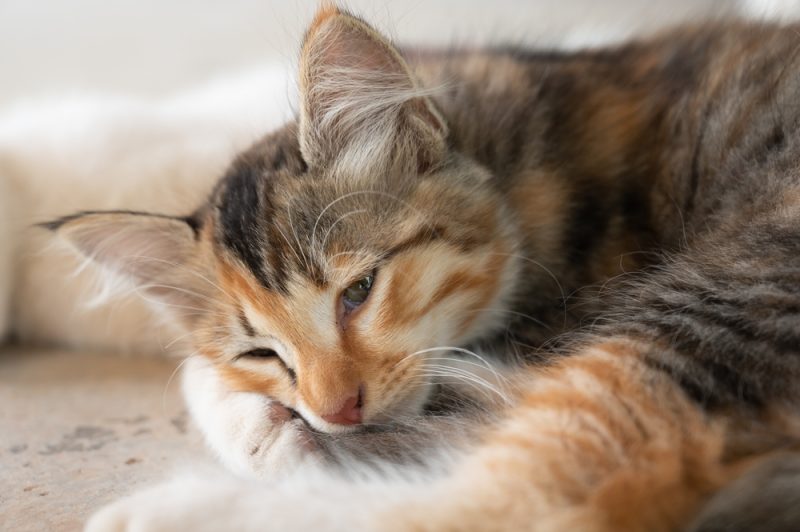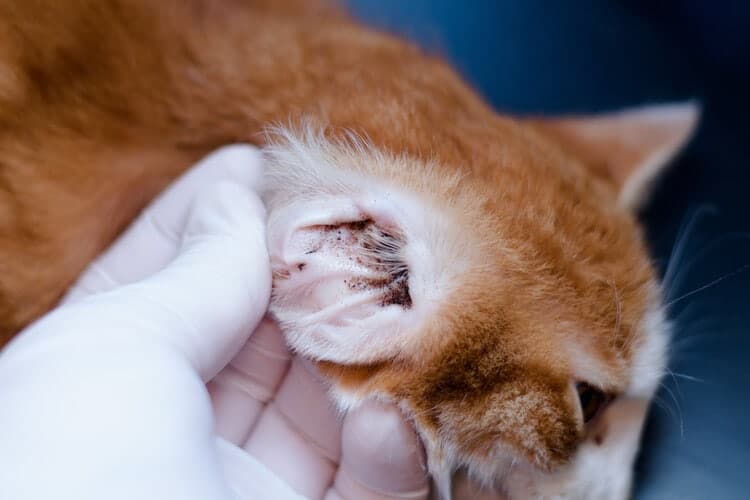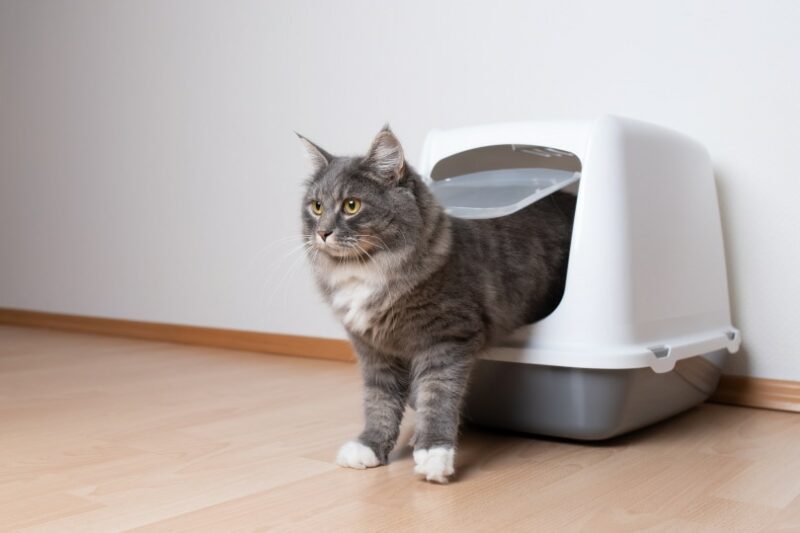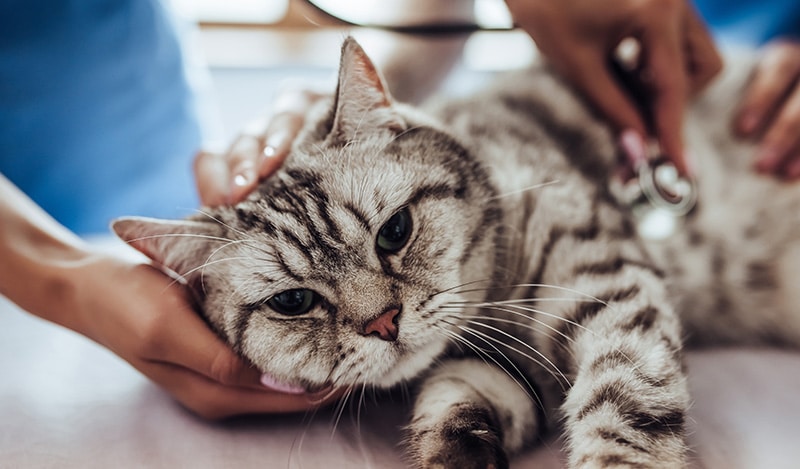In this article
View 4 More +Prosthetics help restore mobility to pets who’ve lost limbs, by allowing them to walk, jump, and run more naturally. Cats do fine with one leg missing, but amputations often result in increased stress being distributed to pets’ spines and remaining limbs, which can cause health problems over the long term.
Without assistance, it can be difficult for amputee cats to jump and balance themselves, which can sometimes limit their ability to engage in everyday activities. That’s where prosthetics come in; they help restore cats to more normal four-legged mobility.

How Does a Three-Legged Cat Prosthesis Work?
There are two types of prostheses: those that attach externally and more permanent options requiring surgical implantation. External designs fit over the nub of the amputated limb and often feature a movable foot at the bottom that boosts mobility.
They’re relatively easy to manufacture and can be useful temporary options as cats are adjusting to life without a limb; 3D printing is often used to produce the products.
There are also more permanent choices that feature two parts, including one that’s surgically implanted in the bone.
One part of the implant is attached to the bone and covered with soft tissue; a metal peg is left extruding onto which the ‘foot’ (exoprosthesis) can be attached. The implanted parts are coated with materials to encourage them to grow sturdily into the bone and to prevent infections from setting in during the healing process.
The exterior part of the prosthesis, which attaches to the securely implanted part, can be removed and replaced. The technology now exists to create 3D-printed titanium implants for cats.

Why Do Cats End Up Losing Limbs?
While some cats are born without a limb, it’s far more common for them to end up with three legs due to trauma or disease-related amputations. Motor vehicle accidents are the most common type of trauma.
As a result, younger male cats tend to be the group most affected; male cats generally go further during their explorations than females do, and they’re more likely to be hit by cars. Studies have shown that cats are twice as likely to have a back leg amputated than a front limb.
Do All Pets Who Lose a Limb Need a Prosthesis?
Many cats do perfectly fine with just three legs, particularly if they’re strong and healthy. It’s relatively common for three-legged cats to have a slightly uneven gait while walking but to be quite elegant when on the run, and most do fine after an adjustment period.
Cats born without a limb adapt well and are okay without a prosthesis, but pets who are overweight or have joint problems have difficulty getting around efficiently after losing a leg. It can be challenging for cats who lose two limbs to navigate life without prostheses.

Success Stories
While cat prostheses aren’t that widespread, there are a few feel-good success stories involving pets getting back on their feet thanks to the help of artificial limbs.
Olive
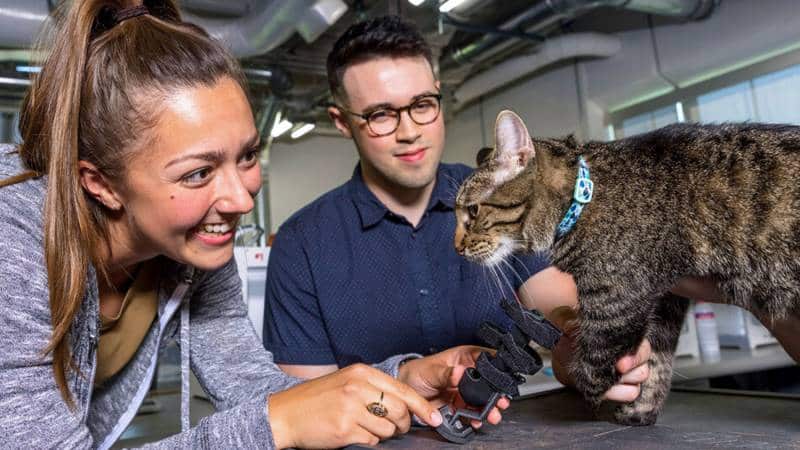
Students at the University of Nebraska-Lincoln designed and made a prosthetic leg for a cat named Olive as part of their senior project using 3D printing and a ton of ingenuity. It all got started when veterinarians at a local shelter in Lincoln reached out to the university to see if the engineering school would be interested in creating an easy-to-use prosthetic that shelters and veterinary practices could use.
Olive, a shelter resident, was tapped for the project, and an assistant professor at the university’s veterinary school began fostering the cat. The students succeeded after a few tries and ended up creating a prosthetic that stays put thanks to a silicone sleeve and a bit of Velcro.
They created a few extras for the Capital Humane Society, which took Olive in. At the end of the day, Olive made several friends through the project, received a new leg, and was adopted by the professor who fostered her.
Vituzzo
Another success story comes from Italy, where an orange tabby cat named Vituzzo, or Vito for short, acquired two prosthetic limbs after having his back paws amputated following a motor vehicle accident. He was the first Italian cat to receive implanted prosthetic devices.
After being injured, it took over a day for Vito to be found and taken to the veterinarian. His injuries were so severe that he needed an immediate amputation on one of his back paws.
The back paw on his other leg eventually became infected and needed to be amputated as well. The accident that injured Vito happened while his humans were away celebrating their honeymoon.
The couple rushed back to be by their companion’s side, worried they may need to prepare themselves for the worst, but their veterinarian had other ideas and suggested considering implanted prosthetic devices.
Vito was given prosthetics with spring-loaded joints that attach directly to his bones. Vito’s Facebook and Instagram pages attest that the surgery was more than successful.
Oscar
Oscar, a gorgeous black cat, made headlines in 2010 when he was the first cat to receive prosthetic implants grafted into the bone after an accident in Jersey. He was about 2 ½ years old when his back paws were accidentally cut off when he was run over by a combine harvester while taking a nap in a field.
A stranger on a bicycle saw the incident and sped off to find help. She knocked on the door of the home where Oscar lived, where she was able to notify the cat’s people that a serious accident had occurred.
Oscar was rushed to the veterinarian, but the damage was so extensive his owners thought euthanasia might be the only option. However, a dedicated veterinarian was able to save Oscar’s life and get him stable. He then suggested that Oscar’s owners speak with a surgeon in England about the possibility of having prosthetic devices implanted.
After several emails, planning, and cooperation, Oscar headed to the United Kingdom for the surgery, during which he received two implants made just for him. Oscar would likely not have survived without the surgery, but the prosthesis gave him a new lease on life.
Before giving Oscar the prosthetics, the surgeon wrapped them in black tape to ensure they blended perfectly with the cat’s midnight fur.
Vincent
Vincent received two implanted prosthetics in 2015; his lower back legs were already missing when he was found at a campsite in Iowa. How the cat ended up injured isn’t clear; no one is sure if he was born missing limbs or suffered an accident. After he was brought to the Story County Animal Shelter, a cat lover who worked there decided to take him home and give him tender, loving care.
The daughter of the woman who took Vincent in happened to be studying to become a veterinarian at Iowa State University and suggested that her mother have the cat looked at by a specialist at the school. Vincent and his family tried physical therapy and used a cart to help him move around before moving forward with the surgery. A veterinary orthopedics company donated the prosthetic devices. Getting Vincent back up on his feet required two operations; the second was needed to replace the initial implants with longer ones to make it easier for him to get around.
After a challenging start in life, Vincent ended up with two prosthetic devices and a forever home. The Story County Animal Shelter worker who decided to take the cat in welcomed him into her family as a permanent addition.
Dymka
Dymka, a gray cat with sweet green eyes, received titanium implants after losing all four paws to frostbite. She was found lying in the snow on the side of a road in Siberia. A kind-hearted animal lover took the cat to a veterinarian who amputated her legs and contacted scientists at Tomsk Polytechnic University (TPU) who developed implants.
The surgery occurred in 2019, and in less than a year, the cat was able to run and navigate stairs on her own. After the surgery, Dymka took up residence at the veterinary hospital where doctors worked so hard to save her.
She has many friendly people around to give her love and attention, and she even has a cat friend, Ryzhik, to keep her company. Limb amputations linked to frostbite occur relatively frequently during the winter in Russia.

Frequently Asked Questions (FAQ)
Are There Ways to Make Life Easier for Amputee Cats?
Absolutely! Ramps can make it easier for cats that can’t get to high perches by jumping to reach their favorite hangouts. Making sure cats who are missing a limb have traction can help them feel comfortable as they’re moving around.
Carpeting can provide a soft surface that also reduces the risk of cats slipping. Putting litter boxes in places that are easy for tripod cats to access can make life just a bit easier, and some benefit from a ramp to help them get in and out of the restroom.
Do Tripod Cats Generally Require Extra Veterinary Care?
Many cats that lose a limb go on to do just fine after recovering from the surgery. However, three-legged pets are at greater risk of developing joint problems and arthritis due to the wear and tear other parts of their bodies receive from their altered gaits and stances.
Are There Ways to Support Amputee Cats’ Overall Health?
Ensuring cats stay a healthy weight is critical to ensuring their long-term health and well-being, as they’re already prone to end up with joint issues, and being overweight adds to the problem. Joint supporting dietary supplements and good weight management, including gentle exercise, can go a long way toward keeping amputee cats happy and healthy over the long term.
Having strong muscles can reduce some of the stress on their other limbs. However, amputee cats tire relatively quickly when exercising, so it’s critical to take things slowly and pay close attention to their reactions.

Conclusion
Prosthetics can allow pets to move more naturally after having a limb amputated. Surgically implanted prosthetics have two parts. One section is implanted in the bone and has a small metal peg that extends through the skin and attaches to the second part of the device, which can be removed.
Stories of cats successfully navigating the world using prosthetic devices abound, from Olive and her mobility-enhancing external foot to cats like Oscar, Vito, Vincent, and Dymka, who received the gift of mobility thanks to surgically implanted prostheses.
Featured Image Credit: Bored Panda. All rights reserved to the copyright owners.


